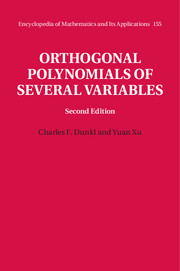Book contents
- Frontmatter
- Contents
- Preface to the Second Edition
- Preface to the First Edition
- 1 Background
- 2 Orthogonal Polynomials in Two Variables
- 3 General Properties of Orthogonal Polynomials in Several Variables
- 4 Orthogonal Polynomials on the Unit Sphere
- 5 Examples of Orthogonal Polynomials in Several Variables
- 6 Root Systems and Coxeter Groups
- 7 Spherical Harmonics Associated with Reflection Groups
- 8 Generalized Classical Orthogonal Polynomials
- 9 Summability of Orthogonal Expansions
- 10 Orthogonal Polynomials Associated with Symmetric Groups
- 11 Orthogonal Polynomials Associated with Octahedral Groups, and Applications
- References
- Author Index
- Symbol Index
- Subject Index
4 - Orthogonal Polynomials on the Unit Sphere
Published online by Cambridge University Press: 05 August 2014
- Frontmatter
- Contents
- Preface to the Second Edition
- Preface to the First Edition
- 1 Background
- 2 Orthogonal Polynomials in Two Variables
- 3 General Properties of Orthogonal Polynomials in Several Variables
- 4 Orthogonal Polynomials on the Unit Sphere
- 5 Examples of Orthogonal Polynomials in Several Variables
- 6 Root Systems and Coxeter Groups
- 7 Spherical Harmonics Associated with Reflection Groups
- 8 Generalized Classical Orthogonal Polynomials
- 9 Summability of Orthogonal Expansions
- 10 Orthogonal Polynomials Associated with Symmetric Groups
- 11 Orthogonal Polynomials Associated with Octahedral Groups, and Applications
- References
- Author Index
- Symbol Index
- Subject Index
Summary
In this chapter we consider orthogonal polynomials with respect to a weight function defined on the unit sphere, the structure of which is not covered by the discussion in the previous chapter. Indeed, if dμis a measure supported on the unit sphere of ℝd then the linear functional ℒ(f) = ∫ f dε is not positive definite in the space of polynomials, as ∫(1 − ∥x∥2)2 dµ = 0. It is positive definite in the space of polynomials restricted to the unit sphere, which is the space in which these orthogonal polynomials are defined.
We consider orthogonal polynomials with respect to the surface measure on the sphere first; these are the spherical harmonics. Our treatment will be brief, since most results and proofs will be given in a more general setting in Chapter 7. The general structure of orthogonal polynomials on the sphere will be derived from the close connection between the orthogonal structures on the sphere and on the unit ball. This connection goes both ways and can be used to study classical orthogonal polynomials on the unit ball. We will also discuss a connection between the orthogonal structures on the unit sphere and on the simplex.
Spherical Harmonics
The Fourier analysis of continuous functions on the unit sphere Sd−1 := {x:∥x∥ = 1} in ℝd is performed by means of spherical harmonics, which are the restrictions of homogeneous harmonic polynomials to the sphere. In this section we present a concise overview of the theory and a construction of an orthogonal basis by means of Gegenbauer polynomials. Further results can be deduced as special cases of theorems in Chapter 7, by taking the weight function there as 1.
Information
- Type
- Chapter
- Information
- Orthogonal Polynomials of Several Variables , pp. 114 - 136Publisher: Cambridge University PressPrint publication year: 2014
